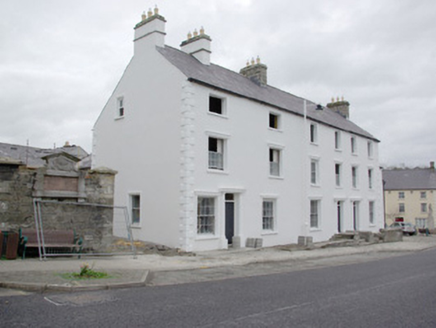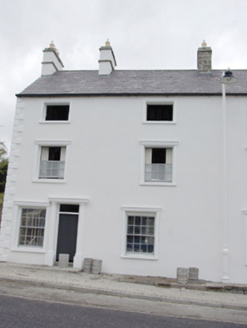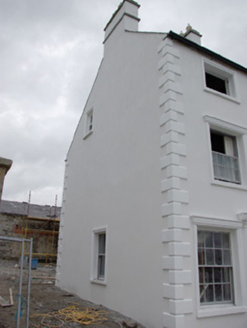Survey Data
Reg No
40850020
Rating
Regional
Categories of Special Interest
Architectural, Historical
Previous Name
Bank House
Original Use
House
Historical Use
Bank/financial institution
In Use As
House
Date
1810 - 1840
Coordinates
210851, 366787
Date Recorded
31/10/2007
Date Updated
--/--/--
Description
End-of-terrace two/three-bay three-storey house with attic level, built c. 1830, having two-storey return and outbuildings to the rear (north). Renovated c. 2007. Originally two separate single-bay three-storey houses now amalgamated to form single property. Formerly also in use as a bank. One of a group of three with buildings adjacent to the east (see 40850018 and 40850019). Pitched natural slate roofs having projecting eaves course, and with a pair of rendered chimneystacks (one to west end and one to the centre) having ashlar granite stringcourses and ashlar granite coping over having modern clayware pots Smooth rendered walls having modern block-and-start quoins to the west corner. Square-headed window openings having replacement eight-over-eight pane timber sliding sash windows at ground and second storey level, and with four-over-four pane timber sliding sash window at second floor level. Render aedicule surrounds (modern) to window openings at ground and first floor level with render architrave surrounds (modern) to window openings at second floor level and to west gable end. Some surviving timber shutters to interior. Square-headed doorway offset to the west side of centre having replacement door, plain overlight, and with modern doorcase having Doric columns supporting entablature over. Set slightly back from road to the centre of Pettigoe. Laneway to the west end gives access to rear with complex of two-storey outbuildings having rubble stone walls, pitched natural slate roofs, square-headed window openings with red brick voussoirs and replacement timber sash windows, and integral segmental-headed carriage-arch having red brick voussoirs and surrounds. Stone gate pier (on square-plan) to the west side of laneway; single-storey outbuilding to the west of lane. Former walled garden (see 40850006) to the rear (north).
Appraisal
This late-Georgian townhouse retains much of its early form despite extensive recent alterations and renovations. While original fittings to the openings have been replaced and new surrounds have been added to the openings, the original style and architectural character of the house has been preserved. This building was originally two separate single-bay properties, recently amalgamated to form a single property with a former doorway to the east now blocked. It was formerly also in use as a bank building, probably with bank manager’s residence to the upper floors. It forms part of an interesting terrace of three (originally four, building to the west end formerly two houses) late Georgian houses (see 40850018 and 40850019) that are unusual to find in a small rural town and is much more commonly encountered in the Georgian suburbs of the larger towns and cities in Ireland, particularly Dublin and Limerick. These buildings may be slightly later than their neighbours adjoining to the east. This building and its related neighbours to the west was originally constructed for/by the Leslie family, the proprietors/landlords of Pettigoe and surrounding areas from sometime shortly before 1666 until recent times. The Leslie family had their main residence and estate at Castle Leslie in County Monaghan and probably used the houses at Pettigoe as a base for hunting etc. (in addition to providing a source of income from rent). According to local information both Winston Churchill (the Churchills were close relatives through marriage of the Leslie family) and Edward Prince of Wales (later Edward VII) both stayed here at some stage as guests of the Leslie family. This fine building, its rear return and the outbuildings to the rear (north) forms part of an interesting group of related structures along with the houses adjacent to the west and the walled garden (see 40850006) to the north, and is an important element of the built heritage and social history of the Pettigoe area.















